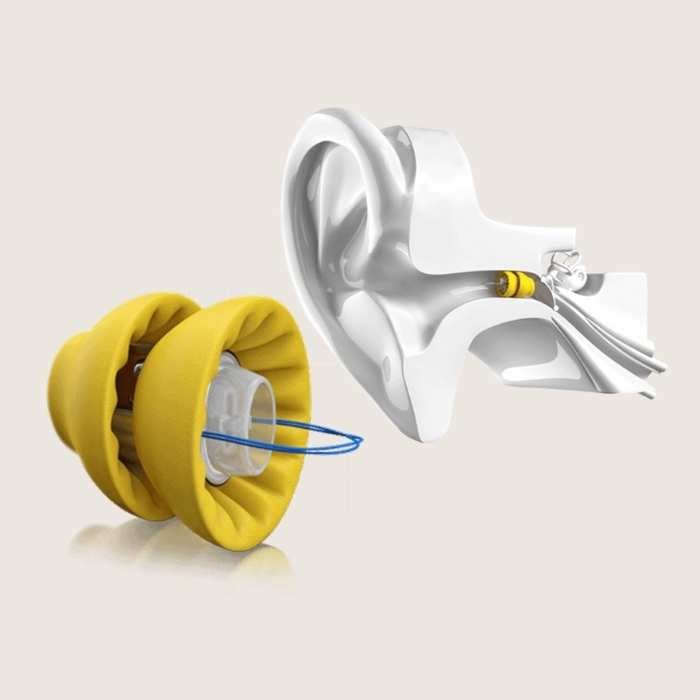It took me years to finally take the plunge into hearing aids. When I did, my first priority was finding something discreet and out of sight and out of the way. That search led me to plenty of options, some credible and others not so much.
Now, years later, this is my guide to the best invisible hearing aids on the market in 2026.
Below we’ll cover over-the-counter devices, prescription options, and even custom-molded fits. If all of this feels new, stick with me.
By the end of this guide you will have a clear sense of the pros and cons of in-the-ear hearing aids, the top products available today, and how to take your next step.

This guide is rooted in my own experience and reviews, but it’s also informed by our audiology team here at Soundly and the thousands of customers we support each month. Together, we hope this gives you the confidence to move forward.
Prefer to watch?
Click play below. Otherwise keep scrolling for the list!
- You have options: Today’s market offers impressive invisible hearing aids, from over-the-counter options like the rechargeable Sony CRE-C20 to custom-built models like the Starkey Signature Series and the continuous-wear Phonak Lyric.
- Don't rule out RIC: Receiver-in-canal devices can also provide a low-profile look, using a slim, clear wire for a discreet fit.
- Bluetooth tradeoffs: Fully in-ear models are compact and hidden, though they generally lack streaming capabilities compared to other styles.
Quick Links
Best OTC Value: Sony CRE-C20
Smallest Rechargeable: Eargo 8
Smallest Overall: Phonak Lyric
Best Custom Mold: Starkey Signature Series
- 50+ hearing aid brands reviewed and rated by our team of hearing aid wearers and audiologists
- 200+ hours each month spent researching brands and care options
- 2,000,000 people shopped on Soundly in 2024
- 100% independently owned and operated
Read more about our company, services and process here.
Featured in this article
We'll start with our favorite OTC, invisible hearing aids.
If you have mild to moderate hearing loss (take our test here), OTC hearing aids are a great place to start. They’re sold online (including here at Soundly) and shipped directly to your home.
When you purchase through Soundly, you’ll receive a complimentary setup call with an audiologist and ongoing support from our team. You’ll still be in the driver’s seat, programming your devices through a smartphone app.
For anyone shopping OTC, we recommend two standouts: Sony CRE-C20 and Eargo 8. Both are well-built and come from credible companies. Our top pick for most people is the Sony CRE-C20. These devices are discreet, reliable, and budget-friendly. The Eargo 8 comes in at a higher price point but also offers a sleek design and excellent sound quality.

Both the Eargo 8 and Sony CRE-C20 fit similarly in the ear. The key differences come down to the app experience, comfort, and price. The Eargo 8 is priced at $2,699, while the Sony CRE-C20 comes in at $999. For most people, we recommend the Sony CRE-C20.

Sony CRE-C20
- Soundly's top-selling in-ear OTC hearing aid
- Nearly invisible in most ears
- 28-hour battery life per charge
- Self-fits through Sony's smartphone app
Sony’s CRE-C20 is a big step up for in-ear OTC hearing aids, packing new features that make it our top pick. Here’s why we chose it:
- Sound Quality Boost: Sony borrowed tech from in-clinic product Signia Silk for sound processing, and the difference is clear. The CRE-C20 delivers noticeably better sound than past models.
- Long-Lasting Battery: With 28 hours on a single charge, you can count on the CRE-C20 to get you through a full day.
- Invisible, Comfortable Fit: Designed to be invisible in most ears, the CRE-C20 fits comfortably and stays discreet—even more so than many other IIC models we’ve reviewed. We especially like the slightly curved design that improves in-ear comfort.
If you’re looking for an in-ear OTC hearing aid, the CRE-C20 wins on sound, battery, and comfort.
Sony CRE-C20 is Soundly's top-performing in-ear OTC hearing aid. Our customers love the discretion and sound quality and often comment on how comfortable CRE-C20 is compared to other in-ear options. Some customers do report that the app setup is more involved than simpler products like Lexie or Sennheiser. Some sample review:
- "Over the past few years, I have tried a half-dozen or more OTC hearing aids and none of them were better than the Sony CRE-C20 aids that I have had the opportunity to evaluate. I have tried less costly and more expensive OTC's - doesn't matter - these were the answer to my inability to hear in many situations." - Ern
- "In terms of function, I was very impressed with the overall sound quality once it was dialed in. Initially they sounded a bit tinny, but that was easily adjusted with the Sound Balance control. It took a couple of days of use and adjusting before I really felt they were dialed in. At that point I wore them all day in different environments to put them through their paces. One of my main concerns is the ability to hear clearly and understand what the person I’m speaking with is saying in a louder environment. The CRE-20Es did a fantastic job with toning out the background noise and producing a clear and easy to understand conversation experience. I tend to have to listen and read lips at the same time but quickly realized I could hear the conversation very well, even in a loud restaurant environment." - Stanley
- "These are IP68 Sweat and water resistant - I was able to wear these biking multiple times without any fear of them falling out or being damaged." - James
- "I shut down and restarted the app, turned off my phone, uninstalled and reinstalled the app, and nothing seemed to work. I tried the next day, and then it worked." - Trobadaur
- C20 is Nearly invisible in most ear canals
- High quality sound for a lower price
- Self-fit at home
- Rechargeable with 28 hours of battery life
- Does not allow Bluetooth streaming
- Requires some tech-savvy for setup
- Only for mild-moderate hearing loss
- Sony CRE-C20 hearing aids are sold over the counter and are appropriate for those with mild-moderate hearing loss
- If you have more significant hearing loss it is recommended that you access professional care through Telehealth or local care
- Available for purchase here Soundly.com with a complimentary guide setup service
- Does not require a prescription from a doctor
- Customize your hearing aids with an onboard hearing test and app-controls
- Sony CRE-C20 is made in collaboration with hearing leader WSA audiology
- Sony CRE-C20 offers good background noise management algorithms and newly re-designed processing chip
- Sony CRE-C20 sits discreetly in the ear and comes with various ear tip sizes
- Sony CRE-C20 is not custom-molded to your ear shape
- Our team finds all in-the-ear models slightly less comfortable for all-day wear than RIC hearing aids
- Sits inside the ear
- Only available in one completely-in-canal size (invisible in many ears)
- Only available in black
- Sony CRE-C20 has rechargeable batteries
- Sony CRE-C20 batteries last 28 hours on a single charge
- The included CRE-C20 carry-case comes with three additional on-the go charges
- Sony CRE-C20 does not come with Bluetooth streaming
- Sony CRE-C20 is a small device which can pose dexterity challenges
- Sony CRE-C20 uses rechargeable batteries and has a convenient charge case with strong magnets that pull the devices into place
- CRE-C20 is water resistant but we recommend you avoid water activities while wearing (i.e. swimming)
- Sony CRE-C20 uses a smartphone app which includes an onboard hearing test and manual controls for bass, treble and volume
- The app is required to make changes (no buttons onboard)
Eargo 8
- Disruptive leader in hearing health, known for sleek, invisible design.
- Rechargeable with a patented ear tip that allows ears to breathe.
- Eargo 8 adapts to your environment automatically throughout the day.
- Budget models (Eargo SE and Eargo LINK) offer lower prices and alternate features.
Eargo has long set the standard for invisible-style design in the hearing aid industry. Their compact devices, along with an intuitive app and thoughtful packaging, make Eargo a standout choice for early adopters. Here’s why we picked it:
- Invisible Design: The Eargo 8 is one of the smallest rechargeable hearing aids on the market, rivaled only by the Sony CRE-C20.
- Reduced Occlusion: Eargo’s patented “floating” ear tip design sits comfortably in the ear without causing occlusion, a common issue for in-ear hearing aid users.
- User-Friendly App: The Eargo app is easy to navigate, and it allows audiologists to remotely adjust your devices as needed, though most adjustments can be managed directly in the app.
Eargo has received numerous customer reviews, reflecting a generally positive reception.
Overall
Customers frequently commend Eargo for its discreet design, sound quality, and responsive customer service. Many users highlight the significant improvement in their hearing experience and the comfort of the devices.
Positives
- Discreet Design: "The Eargo hearing aids are virtually invisible, and no one can tell I'm wearing them." — James D.
- Sound Quality: "The clarity of sound is remarkable; I can hear conversations clearly even in noisy environments." — Charlie B.
- Customer Service: "Eargo's support team was incredibly helpful and guided me through the setup process with ease." — Rowdy G.
Complaints
While the majority of feedback is positive, some customers have reported issues with device durability and the need for adjustments. However, these concerns are relatively infrequent compared to the overall satisfaction expressed by users.
For a comprehensive view of customer experiences, you can visit Eargo's review page.
- Eargo is a tiny, rechargeable device that sits entirely inside the ear
- Eargo uses a unique design that prevents occlusion
- Eargo is self-fit using an app but offers remote support
- Only appropriate for those with mild to moderate hearing loss
- Requires some tinkering to fine tune the product
- Eargo is not Bluetooth enabled due to the tiny size
- Eargo 8 hearing aids are sold over the counter and are appropriate for those with mild-moderate hearing loss
- If you have more significant hearing loss it is recommended that you access professional care through Telehealth or local care
- Available for purchase online or at retail stores like Verizon Victra and Best Buy
- Does not require a prescription from a doctor
- Customize your hearing aids with an onboard hearing test and app-controls
- Eargo has well-developed background noise management algorithms
- Smart Sound Adjust automatically adapts to your environment and focuses on voices
- Eargo sits inside of the ear and is one of the most comfortable in-ear options on the market
- Eargo creates less occlusion than many in-the-ear options
- Our team finds all in-the-ear models slightly less comfortable than RIC hearing aids
- Sit inside the ear
- Only available in one completely-in-canal size (nearly invisible in many ears)
- Only available in black
- Eargo hearing aids are rechargeable
- 16 hours of battery life on a single charge
- Each pair of hearing aids comes with a small and portable recharge case that carries 14 additional charges
- Eargo 8 does not offer Bluetooth streaming
- Eargo 8 is small but comes with rechargeable batteries which prevents difficult battery changes
- Eargo's devices include a pull-tab that makes it easier to place and remove the devices in your ears
- Eargo 8 hearing aids have an IP68 rating, meaning they can be submerged in up to one meter of water for 30 minutes without damage.
- Eargo 8 pairs with a smartphone app that includes an onboard hearing test and manual controls for programs, volume, and sound quality.
- You can also adjust volume and switch programs without the app by simply double-tapping your ear.
A new "invisible-style" entrant into the market.
Nuance Audio is a new product on the market that combines glasses and hearing aids into one device. The open-ear speakers project sound into your ear using an array of directional microphones. In many ways, this is the most invisible hearing aid available. People may notice your glasses, but they’ll never know those glasses are helping you hear.
Nuance Audio glasses are available here at Soundly with ongoing support from our team. If you need prescription lenses, you can take them to a local optometrist. Each pair comes with transition lenses, making them a great option for everyday use and sunglasses.

Nuance Audio Glasses
- Glasses and hearing aids combined
- From the maker of Ray-Ban
- Easy-to-use smartphone app
- Available with multiple style, lenses and colors
Nuance Audio Glasses are one of the most exciting new entries into the hearing aid space.
- Hearing Aids + Glasses: The product combines market-leading eyewear design with a fully functional, open-ear hearing aid.
- Directional Mics: Onboard microphones detect the direction you're facing and deliver real-time amplification of voices directly into your ears.
- Open Ears: Importantly, the glasses don’t go in or over your ear canals, offering both a discreet appearance and a more comfortable, open-ear listening experience.
Nuance is a great option for those with mild-moderate hearing loss or anyone who prefers not to wear traditional hearing aids. The product is available through Soundly here and comes with our full suite of care and support.
Customer feedback on Nuance Glasses has been largely positive, with many users highlighting the open-ear speaker design as comfortable and easy to get used to.
Several people note that the glasses provide clear audio in situations where they would otherwise struggle, making everyday conversations and activities more accessible.
Soundly customers also appreciate the discreet, invisible nature of the device, along with the added convenience of pairing the glasses with prescription or transition lenses.
- Sleek, glasses-style form factor — no in-ear components
- Transitions® lenses included (gray or emerald tint depending on frame color)
- Compatible with prescription lenses via your local optometrist
- Built-in speakers and microphones for discreet hearing support
- No music or media streaming capability
- Battery lasts 8–10 hours — may require midday charging
- Not as powerful as traditional in-ear hearing aids
- Nuance Audio hearing glasses are sold over the counter and are appropriate for those with mild-moderate hearing loss
- If you have more significant hearing loss it is recommended that you access professional care through Telehealth or local care
- Available for purchase here Soundly.com with a complimentary guided setup service
- Does not require a prescription from a doctor
- Customize your hearing glasses using a smartphone app
- Swap your transition lenses for prescription lenses at a local optometrist (prescription lenses not included with purchase)
- Nuance Audio Glasses perform well in background noise (especially in front of you)
- Nuance Audio Glasses leave your ear canals open which can help promote natural awareness
- Nuance Audio Glasses are very comfortable for all day wear due to their open ear design
- Amplification comes through an open speaker placed above the ear canal
- Nuance Audio is the only FDA-cleared pair of hearing glasses on the market at this time
- Nuance Audio Glasses are charged using a charge pad and USBC charger
- Each charge give the user 8-10 hours of wear time (depending on background noise)
- Nuance Audio Glasses do not offer Bluetooth streaming
- Nuance Audio Glasses are among the easiest hearing devices to manage
- No placement of small pieces inside the ear necessary
- Easy charge-pad with bright light to indicate charging
- Protected from sweat, light rain and dust
- Nuance Audio glasses pair with a smartphone app for easy volume control, program updates, and initial calibration
Let’s move on to our favorite prescription invisible hearing aids.
Prescription hearing aids are fit to your ears and programmed to your hearing loss by a local hearing care professional. At the clinic, you’ll choose from a few style options.
- Custom-molded devices are made 1:1 for your ear. They’re comfortable and often less visible thanks to their snug fit.
- Ready-to-wear in-ear devices like the Signia Silk come with a range of sleeves to match your ear size—similar in concept to Eargo or Sony.
- Phonak Lyric is a unique option that sits deep in your ear canal and stays there 24/7 for up to eight weeks before being replaced at your clinic.
Starkey Signature Series
- Latest custom hearing aid line from Starkey, a leader in custom styles
- Made in the U.S. with options from fully invisible to larger rechargeable models
- Powered by Starkey’s AI-enabled Neuro processor for enhanced background noise management
Starkey's Signature Series leverages a long history in custom hearing aids, even trusted by President Ronald Reagan in the 1980s. Here’s why it stands out:
- Custom Fit: Each Signature Series device is crafted to each user’s ear from an in-clinic ear impression, providing unmatched comfort and discreetness.
- Versatile Styles: From a nearly invisible-in-the-canal (IIC) model to a larger rechargeable style with up to 38 hours of power and IP68 water resistance, the Signature Series offers flexibility to suit different needs.
- American-Made Quality: Starkey is the only major hearing aid manufacturer based in the U.S., combining local innovation with decades of expertise.
Starkey’s commitment to personalized, high-quality hearing solutions has made it a trusted name for generations.
- Smallest models are almost entirely invisible
- Starkey is a leader in comfortable custom molded products
- Larger sizes come with Bluetooth rechargeable batteries
- This is a premium device which costs $3,000-$7,000 per pair
- Custom molds require additional lead time and replacement time
- The smallest version of Starkey Genesis AI customs are not rechargeable
- None of the Signature Series devices are Bluetooth enabled
- Regardless of size, Starkey Genesis AI hearing aids are fully customizable, prescription hearing aid appropriate for mild-severe hearing loss
- If you have profound hearing loss, you may be a better fit for Starkey's BTE-style hearing aids
- Starkey Genesis AI hearing aids are prescription devices fit and programmed by a professional
- To create your custom hearing aids, a professional will take earmold impressions in a clinic or in your home. They will then send those impressions to the Starkey manufacturing facility where a one-of-one replica will be created for your hearing aids
- After an initial fitting, you can connect with your care provider remotely through the Starkey app
- Starkey Genesis AI hearing aids come with robust background noise management features including Starkey's deep neural network that makes up to 80M adjustments per hour to match your environment
- Genesis AI custom-molded devices sit comfortably in the ear. Some users with better hearing in lower frequencies prefer an open-fit behind-the-ear style hearing aid that allows more natural sound to pass into the ear canal.
Learn more about the choice between in-the-ear vs. behind the ear styles here.
- Sit inside the ear
- Available sizes include full-shell, half-shell, completely-in-the-canal, invisible-in-canal
- Starkey offers 5 colors including black, pink, light brown, medium brown and dark brown
- Starkey's IIC style is on our list of the best invisible hearing aids available
- Starkey's half-shell and full-shell models are rechargeable with up to 36 hours of battery life
- Starkey's completely-in-canal and invisible-in-canal models use a size 10 disposable battery (lasts 5-7 days)
- Genesis AI offers Bluetooth streaming in full-shell and half-shell models
- Genesis AI does not offer Bluetooth streaming for completely-in-canal (CIC) or invisible-in-canal (IIC) models
- iPhone users can take calls hands-free, while Android users must keep their phones close to pick up outbound audio.
- Genesis AI devices use Apple's MFI connection and Android's ASHA connection to stream content through Bluetooth
The larger, rechargeable models of Genesis AI custom-molded hearing aids are reasonably easy to handle, while the smaller, disposable battery-powered models require more dexterity.
- All models have a single piece that sits in the ear vs. RIC styles with a piece in and behind the ear
- Larger sizes include a push button, while smaller sizes do not
- Rechargeable models use port charging vs. conduction charging (slightly more challenging to handle)
- The smallest sizes require regular battery changes (requires good dexterity)
- Starkey Genesis AI are water resistant with an IP rating of 68
- This hearing aid can withstand dust and water submersion in one meter of water for up to 30 minutes
- Remote care: available through the app with care provider coordination
- Customization: Edge Mode and adjustments in the app
- Tinnitus masking: programs can be created by your hearing healthcare provider
- Find my hearing aid: yes
- Health tracking: activity tracking
Note that Starkey's CIC and IIC sizes do not come with connection to the Starkey app.
Signia Silk
- Virtually invisible fit, fully inside the ear canal
- Smallest rechargeable prescription hearing aid with all-day battery and portable charger
- Dual processors for clear speech in noisy settings, with natural Own Voice Processing (OVP)
- Ready-to-wear with pre-sized click sleeves, no custom molds needed
Signia Silk stands out for its near-invisibility and comfort, offering a discreet in-the-ear design that fits entirely within the ear canal. Here’s why we picked it:
- Invisible Comfort: Signia Silk is one of the smallest in-the-ear hearing aids, making it practically invisible to others.
- Rechargeable Power: It’s the tiniest rechargeable option, giving a full day’s use and coming with a portable charging case for quick and easy recharges on the go.
- Advanced Sound Processing: With dual processors, Signia Silk provides clear speech in noisy environments, while Own Voice Processing (OVP) minimizes the volume of your voice, creating a more natural hearing experience.
- No Custom Molds Needed: Designed for convenience, it’s ready-to-wear with pre-sized click sleeves, skipping the need for custom molds and simplifying fittings.
Users appreciate the discreet design, clear sound quality, and rechargeable batteries. However, some are concerned about the lack of onboard buttons and lack of Bluetooth streaming. Here are a few sample reviews from our partners at Zip Hearing.
- "I have been able to hear sounds I have not heard before. Concerned about the on/off situation. The charging is great, no battery to change." - Tom
- "These Signia Silk Charge&Go hearing aids are miraculous: they are hidden in your ear and basically invisible, but rechargeable, adjustable via the app on your mobile phone and they deliver great quality sound-even in noisy places like restaurants. And no fitting it’s required because they come with multiple size rubber ear pieces, so they’re good to go on your first audiologist visit. Dazzling!" - Allen
- "I'm really impressed with my Signia Silk Charge and Go 7IX. WIth the right provider, I now find them comfortable to wear all day and the difference in my hearing acuity before and after, is amazing. The unfortunate trade off, between supper small CIC's and no blue tooth (that's why I gave them a 4.5), for me, is acceptable." - Jean
- Nearly invisible Professionally programmed
- No custom-mold required
- Rechargeable batteries
- Premium price point $2,998 - $5,000 for a pair
- Requires an in person office visit
- No Bluetooth features due to the size
- No onboard buttons (requires app or remote control)
- Signia Silk hearing aids are appropriate for mild-severe hearing loss
- Silk devices are not custom-molded and may create feedback in some severe cases
- If you have profound hearing loss, you may be a better fit for high-powered BTE hearing aids (not currently offered by Signia)
- Signia hearing aids are prescription devices fit and programmed by a professional
- Unlike other leading in-the-ear style devices, Signia Silk does not require a custom-earmold. Instead the device comes with a range of Click Sleeves that fit a wide range of ears
- After an initial fitting, you can connect with your care provider remotely through the Signia app for fine-tuning and program changes
- Signia uses a unique Split Processing technique helps isolate background noise and boost speech clarity
- Signia's Own Voice Processing (OVP) helps take the edge off of that uncomfortable sound quality of the user's own voice that many patients experience when adjusting to hearing aids
- Signia Silk hearing aids are slightly less comfortable than custom-molded alternatives
- Sit inside the ear
- Only available in one completely-in-canal size (nearly invisible in many ears)
- Choose from two faceplate colors: Black and Mocha
- Signia Silk hearing aids use disposable size 10 batteries (lasts 5-7 days)
- Signia Silk does not come with Bluetooth streaming
- Signia Silk requires regular disposable battery changes and good dexterity.
- Signia Silk hearing aids are not advertised as water resistant. Keep these devices away from water when possible.
- Remote care: Included in the Signia app (not a separate app)
- Customization: Treble/bass, volume, microphone directionality, Signia Assistant
- Tinnitus masking: Customizable options through your hearing care professional
- Find my hearing aid: Not available
- Health tracking: Step tracking, activity (e.g., high intensity versus low), and wear time
Phonak Lyric
- Smallest hearing aid available, designed to sit fully in the ear canal for 24/7 wear
- Replaced every 6-8 weeks for consistently fresh performance
- Waterproof, allowing for swimming and showers without removal
- Delivers natural analog sound with minimal processing, but limited background noise management
Phonak Lyric is a truly unique hearing aid on the market, offering an entirely invisible, "set it and forget it" solution for users seeking simplicity and discretion.
- Effortless Wear: Lyric is designed for continuous, worry-free wear. It stays in place 24/7 and is replaced every 8 weeks by a professional, making it an excellent option for those who prefer not to manage their hearing aid daily. Some users can even learn to change it at home.
- Complete Discretion: Lyric’s position deep in the ear canal makes it truly invisible. Even with close inspection, it’s undetectable, giving users complete confidence in its discreteness.
- Ideal for Dexterity Challenges: With no daily handling required, Lyric is ideal for individuals with dexterity issues or those who prefer a low-maintenance solution. Its effortless setup offers ease without compromising on hearing clarity.
Phonak Lyric combines practicality and innovation, making it a compelling choice for anyone that has the time and resources to go this route.
- Totally invisible Wear 24 hours a day including workouts and water
- Clear sound that uses the natural shape of the ear
- Expensive at $4,000 per year
- Includes in-person changes every 8 weeks
- Lack of background noise suppression technology
- No Bluetooth streaming
- Phonak Lyric hearing aids are appropriate for mild-severe hearing loss
- If you have profound hearing loss, you are a better fit for higher-powered RIC or BTE hearing aids
- Phonak Lyric hearing aids are prescription devices fit and programmed by a professional
- You will return to your audiologist every 8 weeks for hearing aid replacements
- Some users learn to make hearing aid changes themselves at home using a special insertion tool
- Phonak Lyric uses analog sound, preferred by some users, though it lacks advanced background noise management features.
- Lyric benefits from the natural acoustics of the ear canal, which can help improve background noise handling.
- After an initial adjustment period, Phonak Lyric becomes comfortable for most users, with many reporting they forget they're even wearing hearing aids.
- Sit deep inside the ear
- Replaceable using a special insertion tool at your local clinic
- Phonak Lyric devices have an onboard battery that lasts 6-8 weeks, after which the entire unit is replaced.
- Phonak Lyric does not come with Bluetooth streaming
- Phonak Lyric is professionally placed and stays in the ear for 6-8 weeks, making it ideal for users with dexterity challenges.
- Phonak Lyric is water-resistant, allowing for light swimming, daily showers, and exposure to humidity.
- Phonak Lyric does not have an app
- Volume and program changes are made using a magnetic wand accessory

Hearing Aid Styles Explained
Hearing aids can come in different styles. The two primary styles are:
- Receiver-in-Canal (RIC): These are very discrete for most wearers, with a small portion behind the ear connected to a tiny speaker inside the ear canal.
- In-Ear Hearing Aids: These devices are worn in your ear canal, with sizes ranging from totally invisible to a bit more visible.
.jpeg)
There are four common types of in-the-ear hearing aids that you will find online or at an audiologist.
- Invisible In The Canal (IIC) - This tiny style sits inside your ear canal with only a pull tab visible to remove the device.
- Completely In Canal (CIC) - The top of the hearing aid is visible to those looking from the side, but the device is very discreet.
- In The Canal (ITC) - Comfortable but visible. More easily accessed to change the volume or mode.
- ITE - This style is even more accessible and allows for more power and, in some cases, rechargeability and Bluetooth.
Most people who prefer invisible hearing aids will gravitate towards IIC or CIC styles.
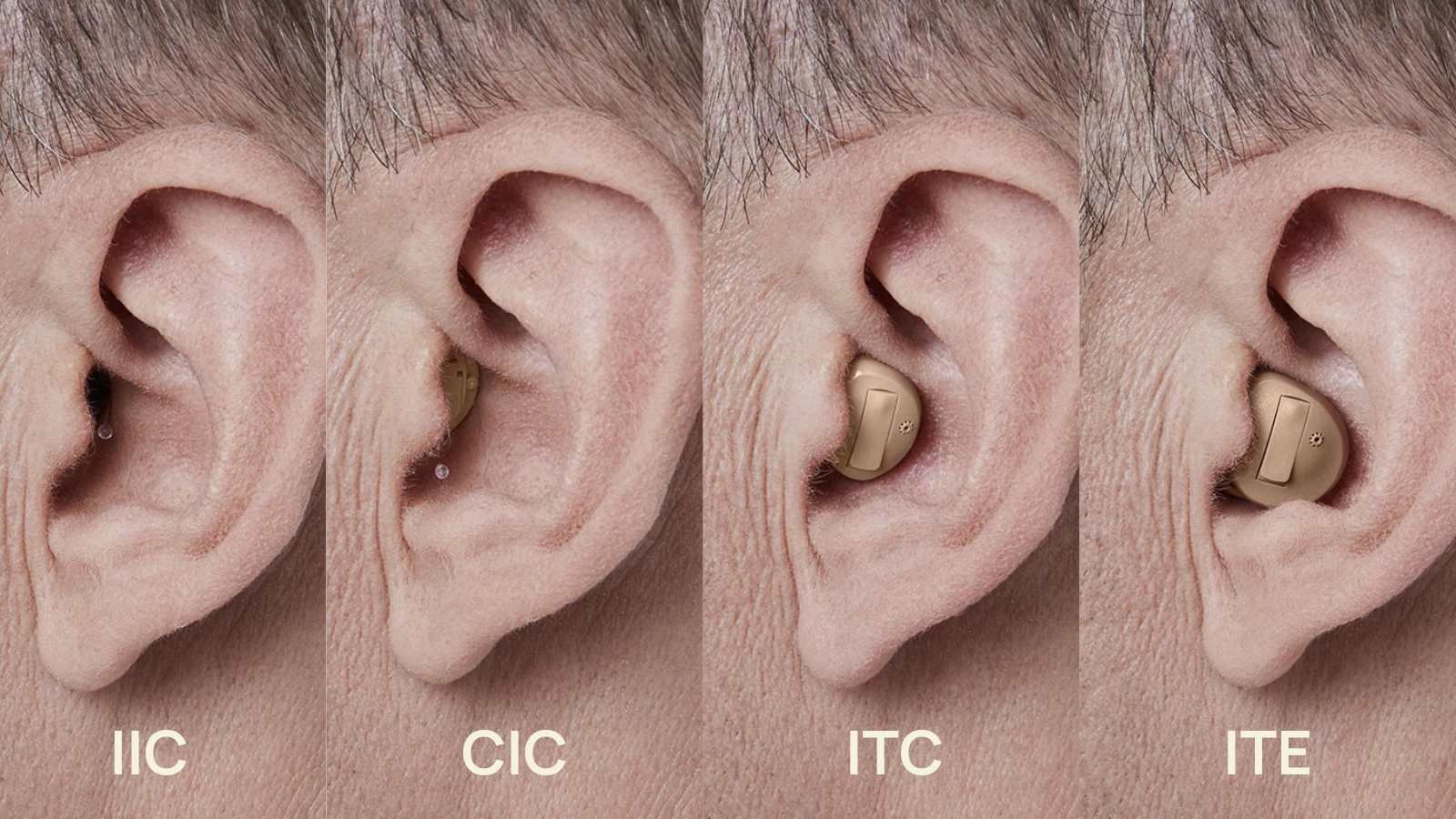
An Alternative Worth Considering
Most hearing aid wearers choose behind-the-ear hearing aids for their comfort, functionality and, yes, relative invisibility.
I know - you're probably thinking "won't that be more noticeable?" Often these devices blend in with hair or blend with the rim of glasses for those who wear them. Let's take a look:
.jpg)
In-canal hearing aids are known for being discreet, but receiver-in-canal (RIC) hearing aids can offer a great mix of low-profile design and high performance. With RIC devices, the tiny speaker sits inside your ear canal, while the rest of the components—like the microphone and processor—sit behind your ear, connected by a thin wire.
That wire is almost invisible and helps keep everything lightweight and comfortable inside the ear. The setup also gives you clear sound and access to modern features like Bluetooth streaming.
We have many customers who are happy with in-ear options like the Sony CRE-C20, and others who prefer behind-the-ear styles like the Sennheiser All Day Clear. Ultimately, it comes down to your preferences and needs—there’s no wrong choice.
Custom Molded Versus ‘Ready to Wear’ Hearing Aids.
Before we wrap up the topic of style, there’s one more important difference to know: custom-molded devices vs. ready-to-wear options. Custom-molded, invisible, hearing aids are typically only available through local clinics, not through online or over-the-counter (OTC) channels. Both options have their pros and cons.
Custom Molded Hearing Aids
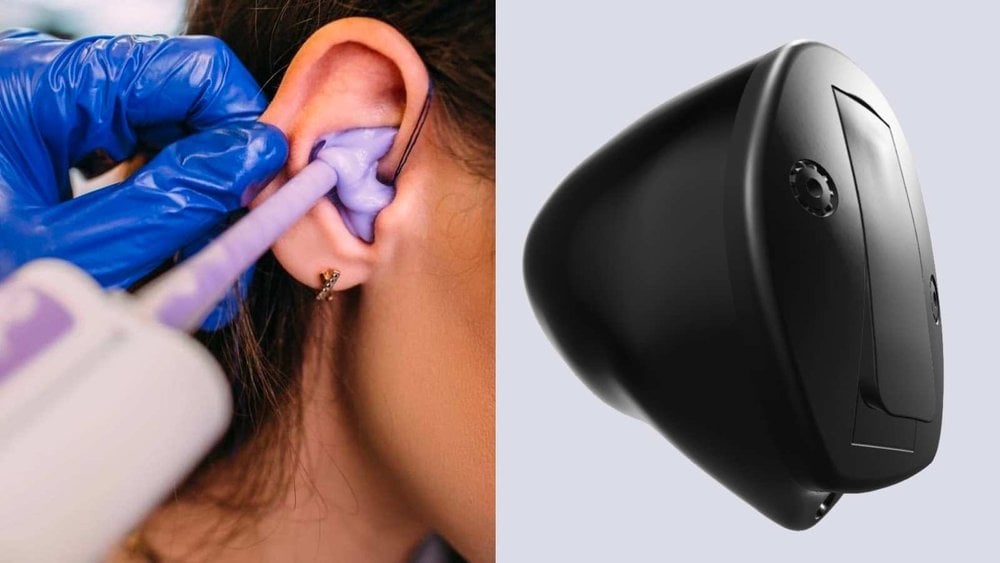
Custom-made hearing aids are crafted using a mold of your ear to create a one-of-a-kind fit. These devices are tailored to your unique ear canal shape, offering a secure fit that stays in place all day. That said, the custom route usually takes more time and comes with a higher price tag.
The process starts at a local clinic, where a specialist takes an impression of your ear. That mold is then sent to a lab, where your device is built and shipped back for a fitting—typically a few weeks later.
Here’s a quick breakdown of the pros and cons:
Custom Hearing Aid Pros
- Built to fit your exact ear canal shape
- Professionally programmed to your hearing loss
- Suitable for mild to severe hearing loss
- Invisible-in-canal (IIC) styles can be nearly undetectable
Custom Hearing Aid Cons
- Typically more expensive than ready-to-wear options
- Takes several weeks from start to finish
- Repairs require sending the device in—no backup while you wait
- May cause a “plugged” feeling if you have normal-to-mild low-frequency hearing
- Not ideal for flat severe or profound hearing loss
Ready-To-Wear Hearing Aids

These devices come with soft dome tips that slip over the receiver and rest in your ear canal. Dome tips are available in different sizes, so you can choose one that feels best for your ear.
While they may not offer the ultra-personalized fit of a custom mold, ready-to-wear hearing aids are an excellent option if you want something fast, flexible, and budget-friendly. They're especially great for first-time users or anyone who wants to try hearing aids without a long wait.
Here’s a quick look at the pros and cons:
Ready-to-Wear Pros
- Fits most ears comfortably with a range of dome sizes
- Soft dome tips provide a gentle, flexible feel in most ears
- Typically more affordable than custom options
- Great for mild to moderate hearing loss
- Many models are self-fitting and easy to set up at home
- Quick replacements are often available if a repair is needed
Ready-to-Wear Considerations
- Not ideal for more severe hearing loss
- While they fit most ears, they may not work as well for unique ear shapes
- May not perform quite as well in background noise as larger customs or RICs
Ready to Try an Invisible Hearing Aid? Let’s Talk Care Models
Once you've landed on an in-ear style, the next step is choosing how you want to get your device: through a prescription care model or an over-the-counter (OTC) option. Both paths can lead to great results—it just depends on your preferences, budget, and the level of support you want along the way.
Option 1: Over-the-Counter (OTC)
OTC hearing aids are designed to be accessible and affordable. You can buy them without visiting a clinic, and most are programmed using a smartphone app. Many OTC products ship quickly and are ready to use right out of the box—no waiting for a custom mold or multiple appointments.
If you're new to hearing aids, keep in mind that there's an adjustment period. Your ears and brain may take some time to adapt to new sounds. The good news is that most OTC devices come with a 45-day (or longer) return window. That gives you time to try them out in your real life and see if they work for you. If they don’t feel right, you’re free to explore other options—including in-clinic care.
OTC Pros
- Often more budget-friendly than prescription devices
- No clinic visit or prescription required
- Quick delivery—no custom manufacturing delay
- Easy self-fitting options available
- Great for mild to moderate hearing loss
- Trial period with return policy gives peace of mind
- Less dependent on clinic availability for setup and follow-up
OTC Considerations
- Support is mostly self-guided (though Soundly includes a complimentary audiologist setup call)
- Sound quality and personalization may vary by brand
- Some users may prefer hands-on help for fitting and adjustments
Option 2: Prescription
Prescription hearing aids come with professional, in-person support from start to finish. If you like having an expert walk you through setup, programming, and adjustments, this route might be a great fit.
With prescription care, a licensed professional helps you choose the right device, takes impressions if needed, and programs the device to match your unique hearing profile. They’ll also help you get comfortable using your hearing aids, and offer ongoing support for cleaning, troubleshooting, and maintenance.
Prescription Pros
- In-person support from a trained clinician
- Professional programming based on your hearing test
- Secure and comfortable fit, with professional adjustments if needed
- Ongoing help with repairs, cleanings, and updates
- Often delivers highly personalized sound quality
Prescription Cons
- Significantly more expensive than OTC options
- Requires clinic appointments for fitting and follow-ups
- Custom devices may take time to manufacture
- Less immediate than ready-to-wear options
Which Path Is Right for You?
Think of this decision like choosing between a custom-tailored suit and one you can buy off the rack—both can look and feel great, depending on the situation. The key is figuring out what matters most to you: convenience, cost, personalization, or hands-on support.
Whichever route you choose, you’re on the path to better hearing—and that’s what really matters.
Final Thoughts
If you’ve made it this far, you’re well on your way to selecting a great invisible hearing aid.
Here’s the Bottom Line
There are excellent invisible hearing aid options on the market at a wide range of price points. Whether you're just beginning your hearing journey or looking to upgrade, the right choice depends on your level of hearing loss, budget, and preferred style of care.
If you have mild to moderate hearing loss and feel comfortable programming your hearing aids (with guidance from our team), ready-to-wear options like the Sony CRE-C20 or Eargo 8 are great places to start. They offer impressive performance in a discreet form and don’t require clinic appointments.
On the other hand, if you’re looking for in-clinic support and professional fitting, we often recommend the Starkey Signature Series or Phonak Lyric. These prescription devices deliver excellent sound quality and personalized care, and Lyric is one of the few hearing aids that’s worn completely invisibly 24/7.
Still deciding? We’re here to help. Feel free to reach out to our team with any questions at [email protected] or give us a call at 1-833-SOUNDLY. We’d be happy to guide you toward the option that feels right for you.


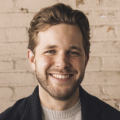

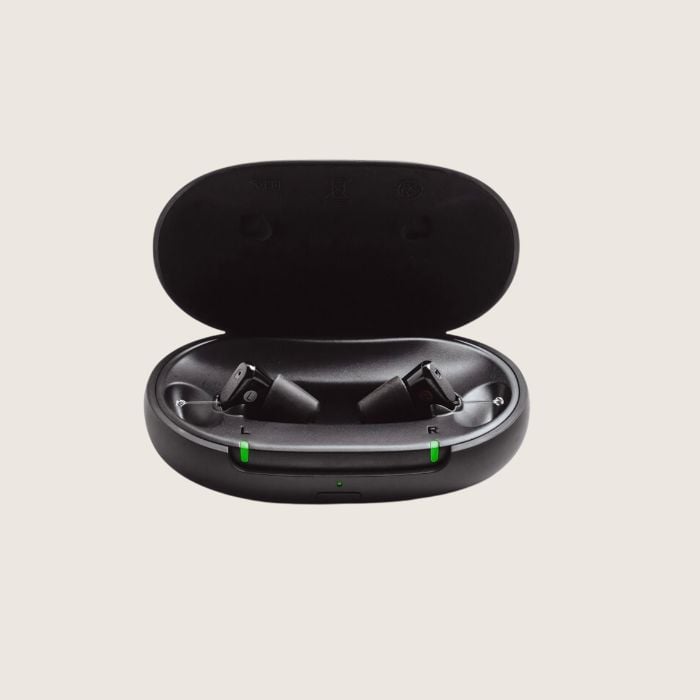
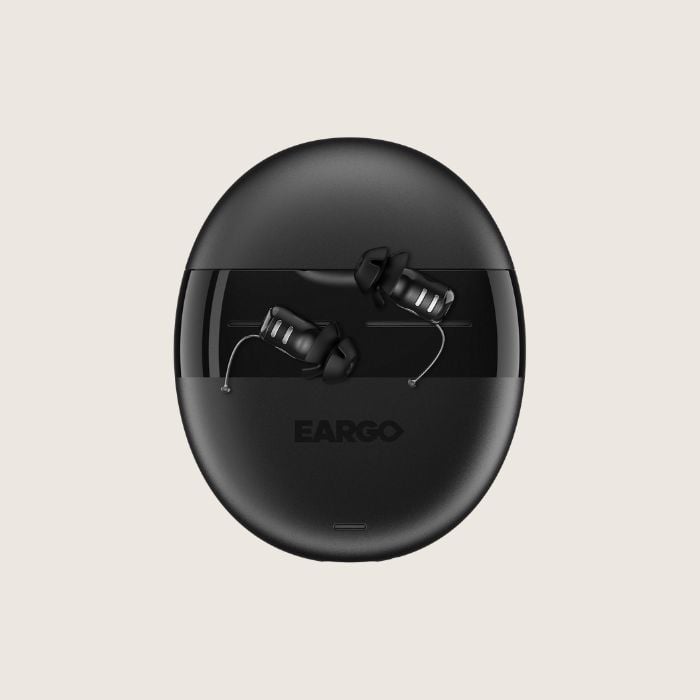
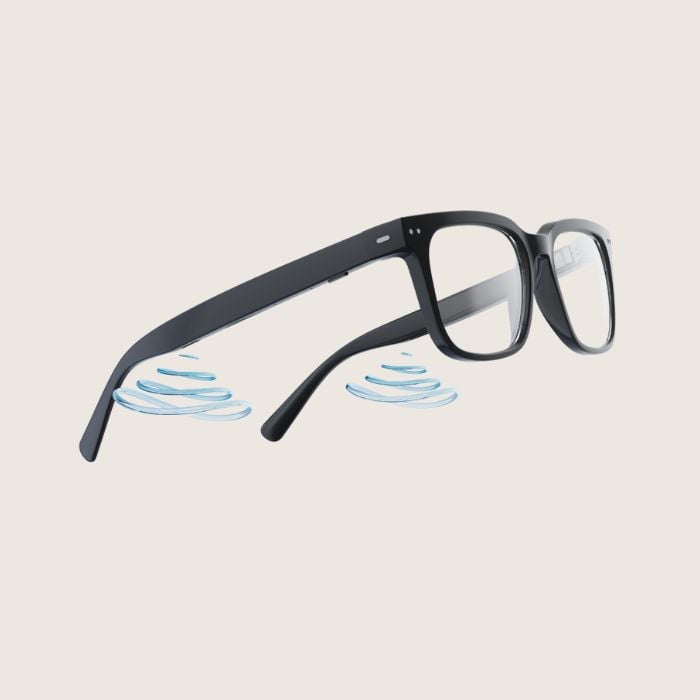
.jpg)

